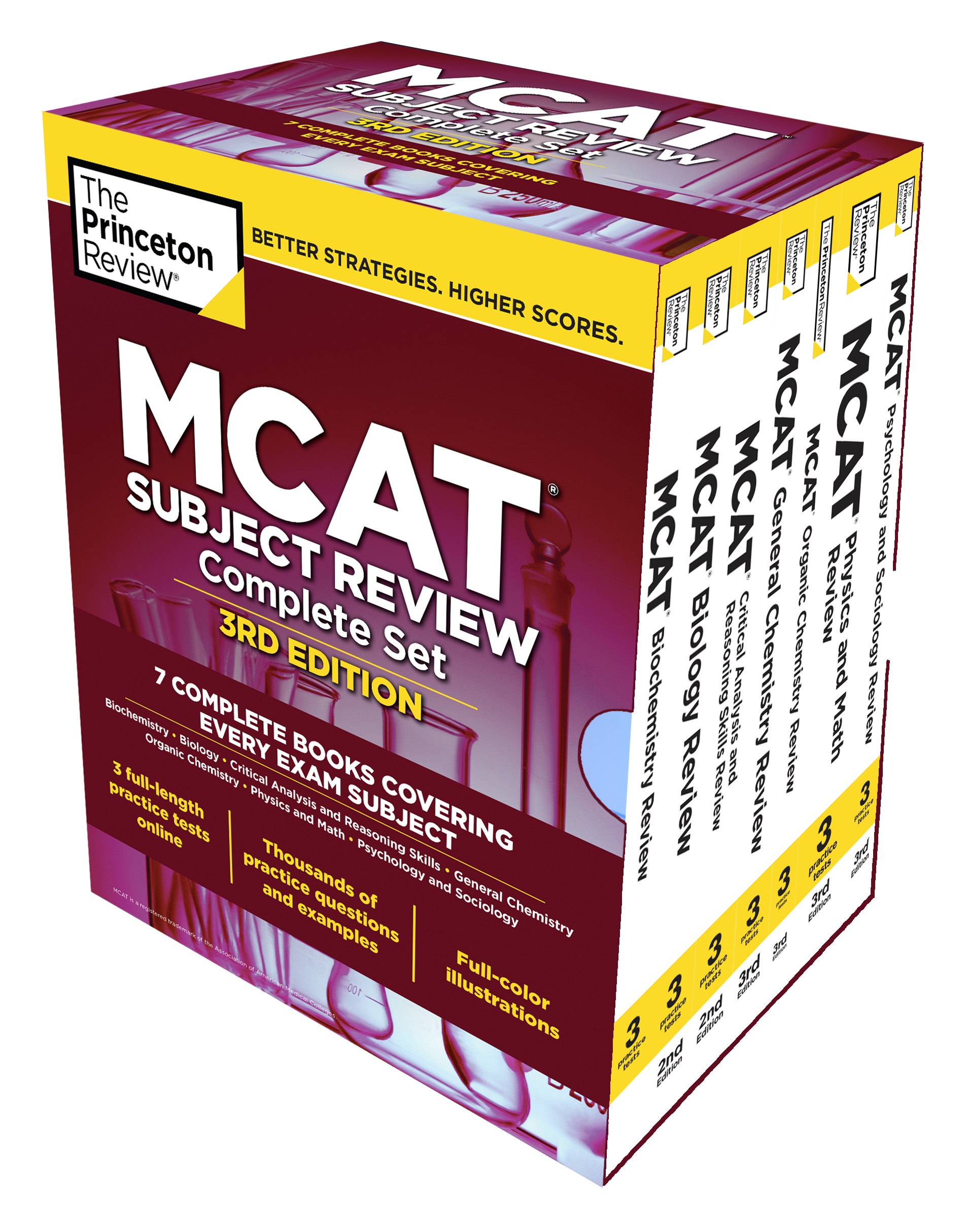
We publish practice problems on our social media pages. Here's where you can find the correct answers—and explanations.
Check us out on Instagram, Facebook, and Twitter!
10/4/20
THE CORRECT ANSWER IS B.
The experimental scenario in the question describes an inhibitor with a plot line that runs through the same x-intercept as the uninhibited measurements; this is indicative of a noncompetitive inhibitor. The x-intercept represents –1/Km; if both the uninhibited and inhibited reactions share the same Km, then the affinity of the enzyme for its substrate has not changed (choice B is correct, and choices A and C are wrong). Changing the concentration of the enzyme will change Vmax, not Km; affinity is not affected by enzyme concentration (choice D is wrong).
10/1/20
THE CORRECT ANSWER IS C.
Uncompetitive inhibition occurs when an inhibitor binds to the enzyme-substrate complex. This decreases the maximal rate of enzyme activity (choice A is a true statement and is not the correct answer) and increases the apparent affinity of the enzyme for the substrate (choice D is a true statement and is not the correct answer). Decreasing the quantity of inhibitors would therefore result in a decrease in apparent affinity (an increase in Km; choice B is a true statement and is not the correct answer). As the inhibitor must bind to the enzyme-substrate complex, it is unlikely that the inhibitor could bind to the active site after the substrate had already bound (choice C is a false statement and is the correct answer).
***
Practice makes perfect! Strengthen your skills with MCAT Subject Review Complete Box Set, available here and wherever books are sold.

***
9/27/20
THE CORRECT ANSWER IS C.
The ovum provides all the organelles when a zygote is formed so mitochondrial disorders are passed from mothers to all of their genetically related offspring (choice C is correct). Y-pattern inheritance is characterized by males passing the gene on to any and all (but only!) males (choice A is wrong). A female inheriting a disorder from her father would mean a connection to the X chromosome (choice B is wrong), and for all offspring to be affected, regardless of the gender of the parent, the disorder would have to express a classical dominance pattern (choice D is wrong).
9/24/20
THE CORRECT ANSWER IS D.
When natural selection removes those exhibiting the extremes of a trait, then the average of that trait will shift over time, creating directional selection. Choice D describes just such a situation and is the correct answer. Choice A describes the force of allopatric isolation as a trigger for speciation and can be eliminated. Choice B describes artificial selection, and choice C describes sexual selection; thus both can be eliminated.
9/20/20
THE CORRECT ANSWER IS D.
Mitosis has only one round of division and its purpose is to recreate diploid daughter cells that are copies of the parent cell. Meiosis has two rounds of division, but at the end of the first round, cells are haploid and contain two copies of that half of the genome (1n, 2x); this is not the same as being diploid (2n, 1x) (choice D is false and therefore the correct answer). Replication occurs before both mitosis and meiosis (choice A is true and can be eliminated), and the nuclear membrane is taken apart to allow for proper division of genetic material in both (choice B is true and can be eliminated). Once the nuclear membrane is gone, microtubules are instrumental in the physical movement to achieve proper genetic division for both (choice C is true and can be eliminated).
9/17/20
THE CORRECT ANSWER IS B.
You can assume that the population follows the Hardy-Weinberg model because it is described as exhibiting random mating. Since the disease is caused by a recessive allele, q = 0.2 and thus 1 – 0.2 = 0.8 = p. The question is looking for carriers, which would mean heterozygous individuals. This is represented by 2pq = 2(0.8)(0.2) = 0.32 (choice B is correct). Choice A represents the frequency of homozygous recessives (0.22 = 0.04) and not the frequency of carriers. Choice C represents the frequency of homozygous dominants (0.82 = 0.64), and choice D represents the frequency of the dominant allele.
9/13/20
THE CORRECT ANSWER IS B.
The time of the entire flight was given, but since you are looking for the maximum height (that is, the y-displacement traveled during each half of the flight), it is useful to remember the fact that, in the absence of air resistance, time up equals time down. This allows you to focus on either the first half of the trip (the way up) or the second half (the way down). Since you are not given the initial launch velocity, it is easier to look at the second half of the journey, where the initial vertical velocity is zero. Calling the positive y-direction downward, you have ay = g and t = 4 s. You want y and you’re missing vy, so use Big 5 #3: y = v0yt + (1/2)ayt2; you have y = 0 + (1/2)(10 m/s2)(4 s)2 = 80 m, or choice B. Alternatively, you would get the same answer by focusing on the way up and using y = vyt – (1/2)ayt2. Note that the angle does not factor into the answer.
9/10/20
THE CORRECT ANSWER IS B.
The question stem describes metoprolol as a competitive inhibitor impacting β-adrenergic receptors, the predominant postsynaptic receptors of the sympathetic nervous system (choice A is wrong). Competitive antagonists bind to the same site on the receptor as the ligand and, unlike non-competitive or other allosteric inhibitors, can be displaced with sufficient quantities of ligand (choice B is correct, and choice C is wrong). Kd for receptors and their ligands is analogous to Km in enzyme-substrate interactions. It is the concentration of ligand at which half the receptors are occupied, and it will increase in the presence of a competitive antagonist (higher concentrations of ligand are required to reach the same saturation point (choice D is wrong).
9/6/20
THE CORRECT ANSWER IS C.
Uneven division of mitotic intracellular debris would lead to increased accumulation of debris in certain cells; this may have an inhibitory effect on the metabolism of those cells, leading to senescence (choice A could contribute to senescence and can be eliminated). Persistence of mutations from errors in DNA synthesis could result in mounting abnormal genetic material. In turn, this would lead to the production of potentially dysfunctional or harmful proteins, increasing senescence (choice B could contribute to senescence and can be eliminated). Telomeres are short sequence repeats found on the ends of linear chromosomes and are typically degraded and shortened during cell division. Initially, because the telomeres are long, this does not present a problem; however, with ongoing rounds of cell division, the telomeres become increasingly shorter and are eventually lost altogether. The loss of the telomere means that with subsequent cell divisions, as the chromosome continues to shorten, there may be losses of important protein coding regions. This could lead to problems with the cell and cellular senescence (choice D can contribute to senescence and can be eliminated). However, the activation of the apoptotic pathway would result in cell death shortly thereafter; once the cell ceases to exist, molecular changes will no longer accumulate in the cell and, thus, it ceases to age (choice C would not contribute to cellular senescence and is the correct answer choice). (Note that telomerase is an enzyme that can lengthen telomeres; cells expressing telomerase are often immortal cells and are able to divide an infinite number of times, further emphasizing the importance of the telomeres in preventing senescence.)
9/3/20
THE CORRECT ANSWER IS B.
DNA gyrase folds and twists the single circular chromosome present in prokaryotic cells. If this enzyme were not functional, the genome could not be properly packed (choice B is correct). DNA polymerase I removes primers in bacteria (choice A is incorrect), helicase initiates replication (choice C is incorrect), and multiple enzymes can perform DNA repair, but gyrase is not one of them (choice D is incorrect).
8/30/20
THE CORRECT ANSWER IS C.
Histones are the proteins around which DNA is wrapped (choice C is correct). Nucleosomes are formed when multiple DNA-wrapped histones are bundled together (choice A is wrong). The endosome is a membrane-bound compartment of the eukaryotic cell responsible for transport of materials from the plasma membrane to the lysosome (choice B is wrong). The centrosome is an organelle that is responsible for organizing microtubules during cell division (choice D is wrong).
8/27/20
THE CORRECT ANSWER IS B.
By definition, products are favored over reactants in an exergonic process (choice B is correct). The predominant contributor to net free energy depends both on enthalpic and entropic factors involving both the transcript and solvent. The stem of the question does not provide adequate information to conclude that intra-molecular nucleotide interactions are the principal factor driving the reaction (choice D is wrong). Folding decreases entropy (ΔS, choice A is wrong), and transcript folding (as with protein folding), results in a decrease in degree of rotational freedom as the macromolecule forms new interactions (choice C is wrong).
8/23/20
THE CORRECT ANSWER IS C.
Dietary fats are stored as triglycerides which have a glycerol backbone and three fatty acid chains which may or may not be the same (choice C is correct, and choice A is wrong). The inclusion of isoprene units is not relevant to dietary fats (choice B is wrong), and the inclusion of a phosphate group creates a phospholipid used in constructing membranes (choice D is wrong).
8/20/20
THE CORRECT ANSWER IS C.
Cholesterol is the precursor to all of the steroid hormones (choice A is a true statement about cholesterol and can be eliminated), and it is used by the liver to make bile (choice B is a true statement about cholesterol and can be eliminated). It is an important component of cell lipid bilayers; its presence helps maintain the correct level of membrane fluidity (choice D is a true statement about cholesterol and can be eliminated). However, while cholesterol is an important precursor for vitamin D (a steroid-like vitamin), it is not the precursor for vitamin A (choice C is not true of cholesterol and is the correct answer choice).
8/16/20
THE CORRECT ANSWER IS D.
Since the protein of interest is localized to the inner mitochondrial membrane, and since knockout of the gene (and thus elimination of the protein) still allows glycolysis to occur, the protein is likely not hexokinase, which catalyzes the first step in glycolysis and is located in the cytosol (choice A can be eliminated). The protein must be involved in a reaction occurring within the mitochondrion, and given that the products of fermentation rapidly accumulate, this appears to indicate a defect in the electron transport chain. Since FADH 2 is still able to deliver its electrons to the chain, the defect must occur upstream of this process. NADH, the other commonly used electron carrier, unloads its high-energy electrons in the first step of the electron transport chain, at NADH dehydrogenase. If this protein were rendered nonfunctional, NADH would no longer be able to make this delivery, but FADH 2 would remain able to do so. As the cell begins to deplete its store of NAD +, it would begin to undergo fermentation in order to regenerate NAD + (choice D is correct). Knockout of pyruvate decarboxylase or citrate synthase would effectively shut down the Krebs cycle but would not account for the difference in NADH versus FADH 2 metabolism (choices B and C are wrong).
8/13/20
THE CORRECT ANSWER IS A.
Carbon monoxide poisoning prevents the delivery of oxygen throughout the body by increasing hemoglobin’s affinity for oxygen. Oxygen normally serves as the terminal electron acceptor in the electron transport chain (ETC). When a cell lacks oxygen, the ETC cannot run and the cell turns to fermentation in order to meet its metabolic demands (choice B is wrong). In humans, this results in the production of lactic acid from pyruvate (choice A is correct). Citrate formation occurs in the first step of the citric acid cycle which cannot operate under anaerobic conditions (choice C is wrong), and there is no reason to suppose that fermentation will result in a net increase in ATP production; ATP levels will likely fall since fermentation produces only 2 net ATP as opposed to 30 from aerobic respiration (choice D is wrong).
8/9/20
THE CORRECT ANSWER IS D.
Catalysts reduce the energy of activation for a reaction (choices A and C can be eliminated), thus making it easier to get to the transition state (TS). This increases the rate of the reaction. ΔG is not affected by the addition of a catalyst; catalysts only affect the kinetics of a reaction, not the thermodynamics. Catalysts are not always specific. Heat and sparks are good general catalysts, but are not specific for particular reactions (choice B is wrong, and choice D is correct).
Read More
Explore Graduate Programs for You
Explore our featured graduate schools & programs to find those that both match your interests and are looking for students like you.
Best Law Schools
Check out our complete list of 164 law schools, based on surveys of school administrators and over 14,000 students.
Search for Medical Schools
Visit our Med School Hub to explore med schools with our ‘Find Your Med School’ filtered search or visit our Med School Advice pages for info about good MCAT scores or interview question prep.

Find MBA Programs Matched to Your Interests
Explore our featured business schools to find those that are looking for students like you.


